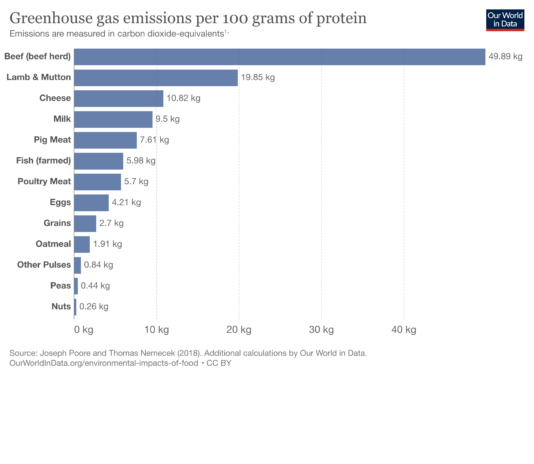- About
- Topics
- Picks
- Audio
- Story
- In-Depth
- Opinion
- News
- Donate
- Signup for our newsletterOur Editors' Best Picks.Send
Read, Debate: Engage.
| May 02, 2023 | |
|---|---|
| topic: | Sustainable Agriculture |
| tags: | #Sustainable Agriculture, #carbon emissions, #future of food, #plant protein, #environment |
| by: | Gerardo Bandera |
Agriculture is one of the most environmentally disruptive human activities, accounting for 50 percent of our carbon dioxide emissions.
As the world's population is expected to grow to 10 billion by 2050, the competing needs to guarantee food security while reducing our greenhouse gas (GHG) emissions challenge us to consume more environmentally-friendly foods without sacrificing nutrition.
By far, the protein sources with the highest greenhouse gas are ruminant animals, notably cattle, sheep and mutton. Ruminant animals, through a digestive process called enteric fermentation, release large amounts of methane, which is 25 times more potent than CO2 at trapping heat in the atmosphere, which warms the planet.
The high emissions caused by these parts of the agricultural industry are also linked to the amount of land that these animals need. Cattle require large plots to roam and graze, as well as large amounts of grass to feed on. Therefore, cattle farms are often guilty of logging, clearing vast swaths of forestlands, the process of which releases high amounts of stored CO2, prevents future CO2 uptake and causes biodiversity loss.
100 grams of beef protein emit about 50 kilogrammes of carbon dioxide equivalents (CO2e) - the largest of any animal protein.
Here’s how other carbon-intensive foods compare to beef per 100 grams of protein.
| Beef | 49.89 kg CO2e |
| Lamb / Mutton | 19.85 kg CO2e |
| Farmed Prawns | 18.19 kg CO2e |
| Cheese | 10.82 kg CO2e |
| Milk | 9.50 kg CO2e |
| Pork | 7.61 kg CO2e |
| Farmed Fish | 5.98 kg CO2e |
| Poultry | 5.70 kg CO2e |
The versatile lentil is both high-fibre and high-protein while also low-carbon (.84 kg /100 g protein) and all around has a positive impact on the environment when farmed sustainably.
Not only do lentil plants absorb carbon dioxide, they also pull nitrogen from the air and store it underground thanks to a symbiotic relationship with nitrogen-fixing bacteria that live on their roots. Because of this, lentils do not require fertilisers to grow, and are also effective at converting nutrients into protein.
Peas are widely known for being efficient sources of protein - accounting for a quarter of their weight, while only producing 0.44 kg of carbon emissions per 100 grams of protein.
Pea plants are nitrogen-fixing, which means they can convert atmospheric nitrogen into a form that can be used by the plant, reducing the need for synthetic fertilisers. Pea crops also require less water and pesticides than other crops, further reducing their environmental impact.
The growing and harvesting of nuts generally releases minimal carbon dioxide into the atmosphere - 0.26kg per 100g protein on average. Yet, not all nuts have the same environmental impact: almonds, cashews and pistachios, for example, release higher CO2 emissions than peanuts or hazelnuts.
Despite the low carbon emissions, however, not all nuts are environmentally-friendly, since their harvesting requires large amounts of natural resources, especially water.
Cashews, chestnuts, almonds and pistachios use large amounts of water - between 65 and 100 litres per gram of protein! This is why, considering the overall environmental impact of our food, it is important to factor in much more than just its carbon footprint.
When sourced sustainably, tofu (made from soy) is a high-protein source with a low-environmental impact, releasing less than two kg of CO2 per 1000 g of protein.
While many sources have decried that the demand for tofu has caused further deforestation in Latin America, only six percent of the soy that is produced goes towards human consumption, while over 70 percent is used for animal feed.
In fact, the high demand for animal meat has led to the creation of many new farms to grow soy and maize, which are cheap and efficient foods to fatten livestock and achieve market price.
High-protein seeds, such as chia, pumpkin, hemp and flaxseeds are environmentally friendly sources of nutrients. Seeds require much less water to grow than most other proteins (80 percent less than beef and 20 percent less than pistachios), and they actually have a very low carbon footprint. This is because plants, such as the hemp plant, absorb more CO2 from the air than is emitted during their harvesting and packaging.
Some studies have shown that hemp farms absorb more CO2 from the atmosphere than forests, making them important carbon sinks.
Apart from producing little GHG emissions, oats are often grown over winters as a cover crop to conserve and replenish soil quality.
Since oats are conservation tilled, their harvesting causes minimal soil erosion or carbon dioxide releases from the soil. They also help pulses and beans grow more efficiently when planted in rotation.
Chicken eggs provide large amounts of protein, as well as other important nutrients, while having a relatively-low environmental impact compared to other animal byproducts.
The most important factors when choosing sustainable eggs are ensuring that their feed is both natural for chickens to eat and sourced sustainably.
Spirulina is a highly nutritious blue-green algae with an uncommonly high protein content - over 70 percent of its weight is protein, more than twice as much as beef. It also contains higher concentrations of nutrients than beef, such as iron and calcium.
Some spirulina-producing factories that operate on renewable resources have found innovative methods to make their production carbon neutral.
While most nations have yet to pass regulations regarding cell-based meat, this option is slowly being explored as a sustainable alternative to raising and slaughtering animals. Instead, scientists effectively ‘grow’ muscles and tissues in a lab by providing nutrients to the cells to replicate.
Due to the energy needed to power the labs, lab grown meat still produces more GHG emissions than most plant-based options; however, at only 5.6 kg CO2e per 100g of protein, lab grown meat’s emissions are 88 percent lower than beef.
Insects are a promising alternative source of protein that can help reduce carbon emissions and provide environmental benefits. Compared to traditional livestock farming, insect farming requires significantly less land, water and feed and produces fewer greenhouse gas emissions.
Insects also have a high feed conversion efficiency, meaning that they convert the feed they consume into body mass more efficiently than traditional livestock.
Protein-rich insects, such as crickets, grasshoppers and locusts, can be made into protein powders or flours, animal feed or tasty dishes like tacos and chocolates.
Image by Betty Subrizi.
By copying the embed code below, you agree to adhere to our republishing guidelines.

